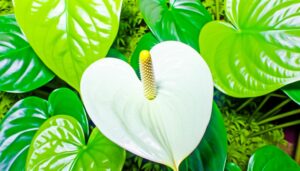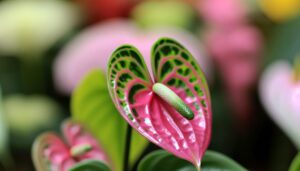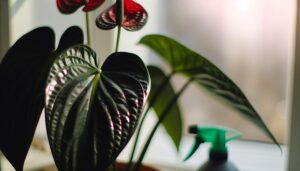Comprehensive Guide to Caring for Anthurium Black Corong
To care for your Anthurium Black Corong, make sure it gets bright, indirect light—an east-facing window works well. Water every 1-2 weeks using distilled or rainwater, and check soil moisture with a hygrometer.
Use well-draining, slightly acidic soil (pH 5.5-6.5) with peat moss, pine bark, and perlite. Maintain temperatures between 65-80°F and humidity above 60%, adjusting with a heater or fan as needed.
Fertilize with a 20-20-20 N-P-K, water-soluble solution every 4-6 weeks at half strength. Repot using minimal root disturbance and prune dead foliage.
Regular pest inspections and appropriate treatments will keep your plant healthy. Continue for detailed care insights.
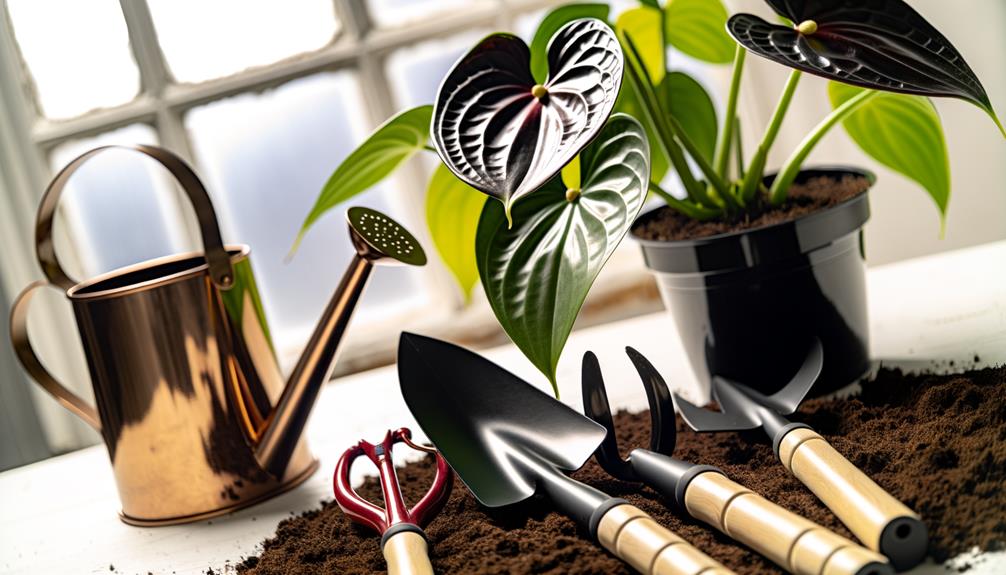
Key Takeaways
- Provide bright, indirect light and avoid direct sunlight to protect the Anthurium Black Corong.
- Water every 1-2 weeks using distilled or rainwater when the top inch of soil is dry.
- Maintain temperatures between 65-80°F and keep humidity above 60% for optimal growth.
- Use a well-draining, slightly acidic soil mix and incorporate slow-release fertilizer.
- Regularly inspect for pests and use insecticidal soap or neem oil for control.
Ideal Lighting

To maximize expansion, place your Anthurium Black Corong in bright, indirect light, avoiding direct sunlight to prevent leaf scorching. Position it near an east-facing window where it receives morning light, which is less intense.
If natural light is insufficient, use full-spectrum grow lights for 12-14 hours daily to replicate prime photoperiods. Monitor the light intensity using a light meter, aiming for 10,000 to 20,000 lux.
Be aware that insufficient light can lead to etiolation, characterized by elongated stems and pale leaves. Rotate the plant every few days to guarantee uniform light exposure, promoting even expansion.
Regularly clean the leaves with a damp cloth to optimize photosynthetic efficiency, ensuring your plant thrives in its luminous environment.
Watering Techniques
To guarantee your Anthurium Black Corong thrives, maintain a consistent watering schedule, ideally every one to two weeks.
Monitor soil moisture levels using a hygrometer; the substrate should be slightly moist but not waterlogged.
Utilize distilled or rainwater to prevent mineral buildup, as these plants are sensitive to water quality.
Optimal Watering Frequency
Ensuring perfect watering frequency for Anthurium Black Corong requires understanding its specific hydration needs and employing precise watering techniques to prevent root rot and promote healthy growth. Water your plant when the top inch of the soil feels dry to the touch.
Use a watering can with a narrow spout to direct water towards the base of the plant, ensuring minimal disturbance to the foliage. Avoid waterlogging by allowing water to drain fully from the pot. Utilize room-temperature, dechlorinated water to maintain ideal root health.
During the growing season, typically spring and summer, increase watering frequency, ensuring the root zone remains consistently moist but not saturated. Reduce watering in winter, allowing the soil to dry slightly between waterings.
Soil Moisture Levels
Regularly monitoring soil moisture levels is important for the health of your Anthurium Black Corong, as it helps prevent overwatering and under-watering, both of which can stress the plant.
Insert a moisture meter into the soil to a depth of 2-3 inches. Aim for a reading between 40-60% moisture content. If you don’t have a meter, use your finger; the top inch should feel slightly dry before re-watering.
Make sure your pot has drainage holes to prevent waterlogging. Apply water until it flows from the bottom, then let it drain completely. Avoid letting the plant sit in standing water.
Consistent moisture levels promote root aeration and nutrient uptake, important for vibrant foliage and overall plant health.
Water Quality Importance
When watering your Anthurium Black Corong, use filtered or distilled water to minimize the risk of mineral buildup and chemical contamination.
Tap water often contains chlorine, fluoride, and other dissolved ions that can harm your plant’s delicate root system.
Make sure the water is at room temperature to prevent thermal shock. Watering should be consistent but not excessive; aim for soil that remains moist but not waterlogged.
| Water Type | Impact on Anthurium Black Corong |
|---|---|
| Tap Water | Potential for chlorine and fluoride damage |
| Filtered Water | Reduced risk of mineral buildup |
| Distilled Water | Ideal for preventing contamination |
Check the soil’s moisture level regularly using a moisture meter. Overwatering can lead to root rot, while underwatering can cause dehydration.
Soil Preferences
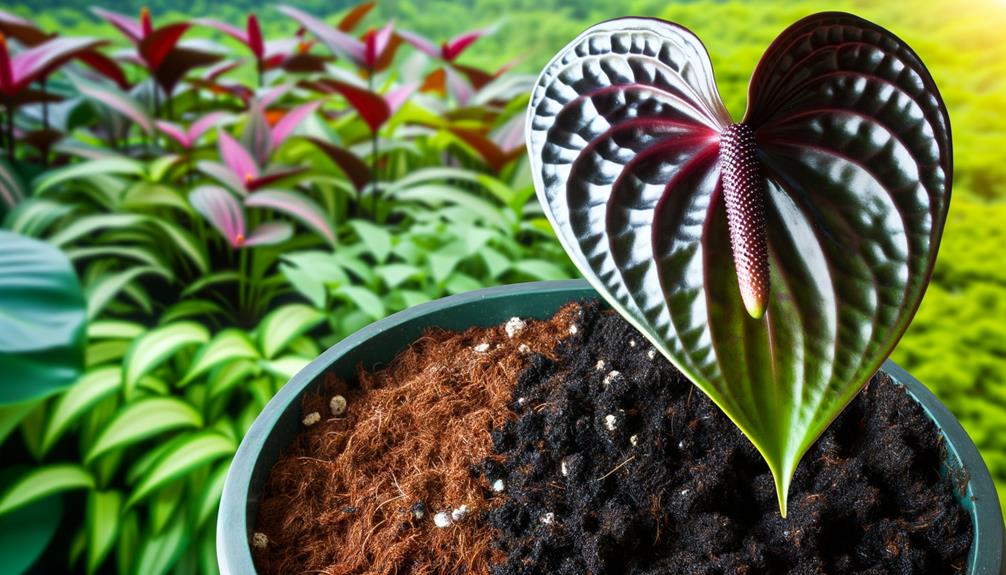
For ideal growth, Anthurium Black Corong requires a well-draining soil mixture rich in organic matter, such as a blend of peat moss, pine bark, and perlite. You’ll want to make sure the soil pH remains slightly acidic, ideally between 5.5 and 6.5.
The peat moss provides moisture retention, while pine bark aids in aeration, and perlite guarantees excellent drainage. Combine these components at a ratio of 2:1:1, respectively, to optimize nutrient uptake and root health.
Regularly check the soil for compaction; it should remain loose and airy. Avoid using heavy garden soil, as it retains too much moisture and can lead to root rot. Incorporate a slow-release fertilizer to support your Anthurium’s growth and vibrant foliage.
Temperature and Humidity
Keeping the Anthurium Black Corong’s health requires maintaining the ambient temperature between 65-80°F, avoiding sudden fluctuations.
Guarantee humidity levels remain consistently above 60% to mimic its native tropical environment. During colder seasons, use a humidifier and avoid placing the plant near drafts or heating vents.
Ideal Temperature Range
Ensuring the Anthurium Black Corong thrives involves keeping the ambient temperature between 70-85°F (21-29°C) with humidity levels consistently above 60%.
To maintain this range, you need to monitor the microclimate closely. Use a reliable digital thermometer to regularly check temperature readings.
If temperatures drop below 70°F (21°C), employ a space heater or heat mat to elevate warmth. Conversely, if they exceed 85°F (29°C), implement a fan or air conditioning unit to cool the environment.
Sudden temperature fluctuations can stress the plant, so aim for stability.
Humidity Level Requirements
Humidity levels should stay above 60% to replicate the Anthurium Black Corong’s native tropical environment. You must utilize a hygrometer to precisely monitor indoor humidity.
Place the plant in a well-humidified room, such as a bathroom or kitchen, or use a humidifier to maintain ideal conditions. Regularly misting the foliage with distilled water can also help sustain necessary moisture levels.
Keep air circulation unobstructed to prevent fungal growth.
Utilize a pebble tray filled with water beneath the plant to elevate humidity through evaporation.
Avoid placing the plant near heating or cooling vents, which can significantly reduce humidity levels.
Seasonal Care Tips
To enhance the growth of your Anthurium Black Corong, you should maintain a consistent temperature range of 70-85°F (21-29°C) throughout the year.
Avoid exposing the plant to temperatures below 60°F (15°C) as it may hinder metabolic processes, leading to stunted growth.
During winter, make sure that your Anthurium is away from cold drafts and heating vents which can cause temperature fluctuations.
For humidity, aim for a relative humidity level of 70-80%. Use a hygrometer to monitor levels. In drier months, increase humidity by misting the leaves with distilled water, using a humidifier, or placing a tray of water near the plant.
Proper humidity prevents desiccation of the foliage and promotes ideal physiological function.
Fertilization Tips
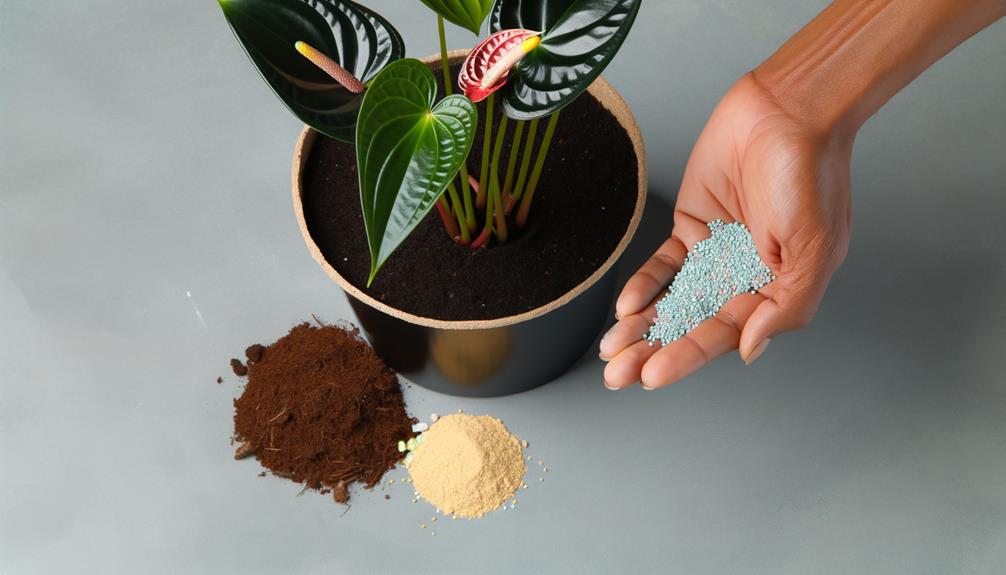
Feeding your Anthurium Black Corong with a balanced, water-soluble fertilizer every four to six weeks will support best growth and vibrant blooms.
Choose a fertilizer with an N-P-K ratio of 20-20-20. Dilute the fertilizer to half the recommended strength to prevent root burn. Apply the solution directly to the soil, ensuring even distribution around the root zone.
- Frequency: Fertilize every 4-6 weeks during active growth periods.
- Method: Utilize a diluted, water-soluble formula.
- Nutrient Ratio: Select a balanced 20-20-20 N-P-K fertilizer.
Monitor the leaf coloration and growth rate to adjust fertilization as needed. Remember, over-fertilizing can lead to salt build-up and nutrient imbalances. Prioritize consistency and moderation for best plant health.
Repotting Guidelines
Repot your Anthurium Black Corong annually during spring to prevent root binding and maximize nutrient absorption.
Begin by selecting a pot that’s 1-2 inches larger in diameter than the current one. Carefully remove the plant, ensuring minimal disturbance to the root system. Inspect the roots for rot or damage, trimming any unhealthy sections with sterilized scissors.
Prepare a well-draining potting mix, ideally a blend of orchid bark, perlite, and peat moss. Position the Anthurium centrally in the new pot, filling in around the roots with the potting mix. Gently compact the soil to eliminate air pockets but avoid overpacking.
Water thoroughly to settle the soil, and place the plant in bright, indirect light to acclimate.
Pruning and Maintenance
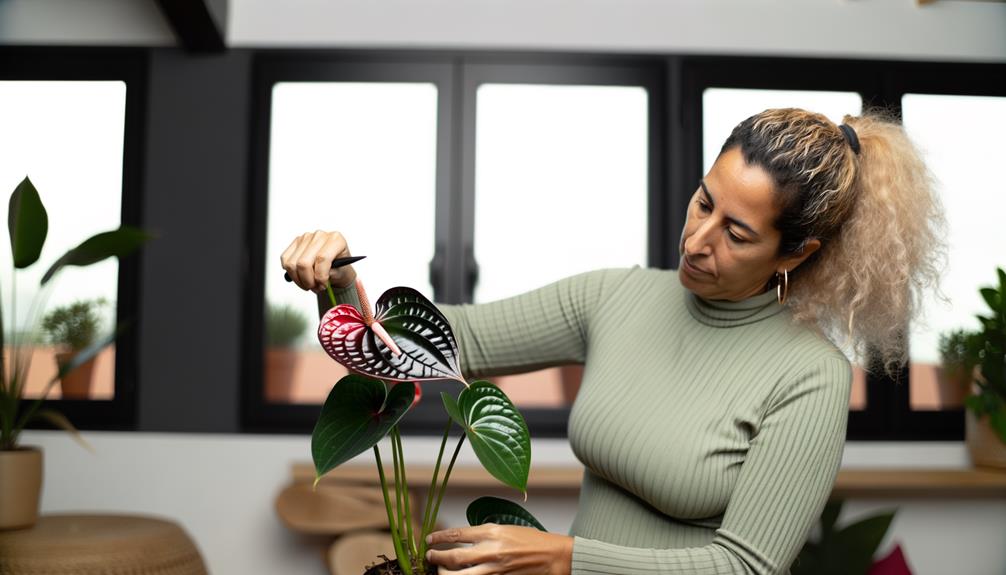
After repotting, it’s important to focus on pruning and maintenance to guarantee your Anthurium Black Corong remains healthy and visually appealing.
Regular pruning promotes robust growth by removing senescent leaves and spent inflorescences. Utilize sterilized pruning shears to minimize pathogen transmission.
Key actions include:
- Trimming dead or yellowing leaves: Remove at the base to prevent nutrient depletion.
- Cutting spent flowers: This redirects the plant’s energy toward new growth and flowering.
- Inspecting for damaged roots: Prune any that are decayed or infected to maintain root system integrity.
Consistently monitor the plant, applying these techniques as necessary.
Pest Management
Effective pest management for your Anthurium Black Corong involves regular inspections and timely interventions to prevent infestations from common pests like aphids, mealybugs, and spider mites.
Begin by thoroughly examining the undersides of leaves, where these pests often gather. Use a magnifying glass for precision.
If you detect pests, apply insecticidal soap or neem oil, guaranteeing full coverage of affected areas.
For severe infestations, consider systemic insecticides containing imidacloprid. Maintain ideal humidity levels, as dry conditions can worsen pest issues.
Additionally, isolate infested plants to prevent cross-contamination. Regularly clean leaves with a damp cloth to remove dust and potential eggs.
Finally, introduce beneficial insects, such as ladybugs, to naturally reduce pest populations. Consistent vigilance ensures a healthy Anthurium Black Corong.
Common Issues and Solutions
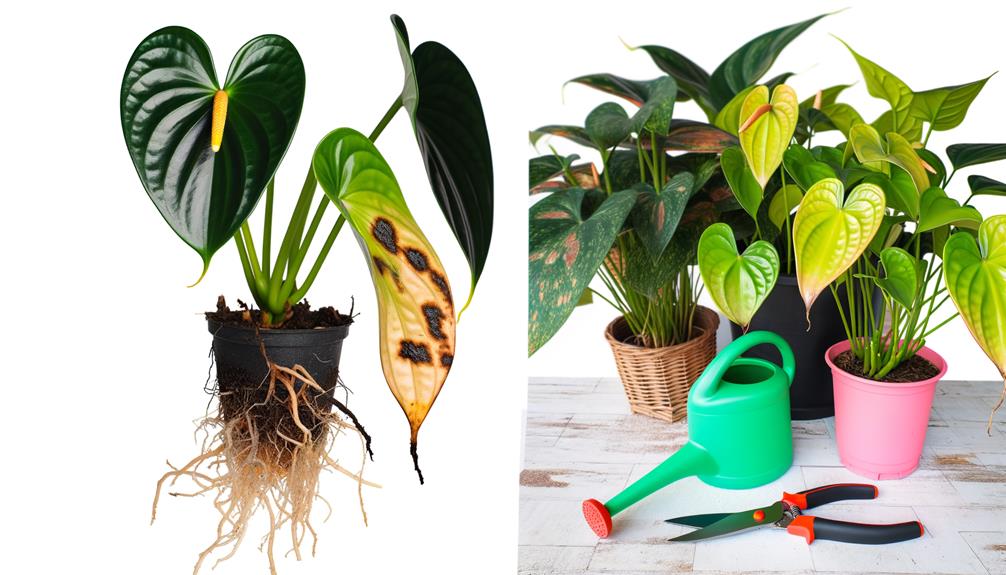
When caring for Anthurium Black Corong, you’ll often encounter issues like root rot, nutrient deficiencies, and improper lighting, each requiring specific solutions to guarantee plant health.
To address root rot, provide well-draining soil and avoid overwatering.
For nutrient deficiencies, use a balanced fertilizer with essential macronutrients like nitrogen, phosphorus, and potassium.
Improper lighting can be resolved by offering indirect sunlight, avoiding direct exposure that can scorch leaves.
- Root Rot: Maintain aerated, well-draining soil; refrain from waterlogging substrates.
- Nutrient Deficiencies: Administer a balanced, water-soluble fertilizer every 4-6 weeks.
- Improper Lighting: Place the plant in bright, indirect light; utilize grow lights if natural light is inadequate.
Conclusion
Caring for your Anthurium Black Corong is a rewarding endeavor that requires attention to detail. With the right lighting, watering, soil, and temperature, you’ll see it thrive. Remember, fertilizing, repotting, and pruning are essential to maintaining its health.
Stay vigilant for pests and common issues—nip them in the bud. Think of your anthurium as a delicate symphony; every element must be in harmony for it to flourish.
Happy gardening, and may your plant prosper!


